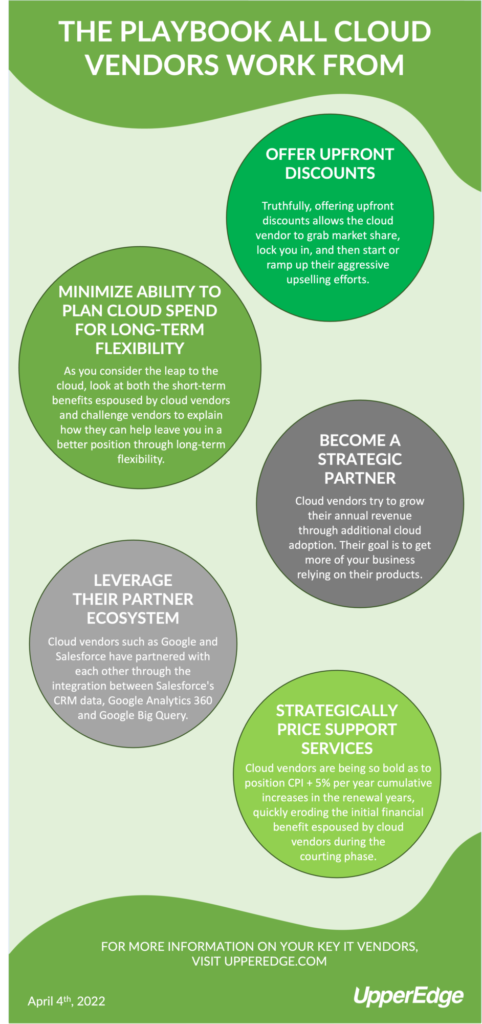- Adam Mansfield
- Reading Time: 5 minutes

Transitioning to the cloud and undergoing cloud transformations have become commonplace for enterprise customers. As such, it is hard to ignore the success of the cloud SaaS offerings from Amazon Web Services (AWS), Microsoft Azure, and Google Cloud Platform (GCP) when these vendors continue to report high year-over-year revenue growth.
If you are implementing a SaaS cloud application, you likely need that value to be brought to intended users in a short timeframe to achieve a desired competitive advantage. You have no time to waste trying to understand cloud vendor strategy.
After taking a closer look, you’ll notice that cloud vendors all take a similar approach to the market and follow the same playbook designed to attract and retain your business. Below are a few key techniques that make up most cloud vendors’ blueprints for success and discuss what you need to keep in mind when you negotiate cloud contracts and make the long-term commitment to a cloud environment.

Offer Upfront Discounts
To get your attention, cloud vendors often offer enticing upfront discounts that can be so significant that the solution seems essentially free. They’ll also offer appealing trial subscriptions where a small portion of your users can test out the solution for a short amount of time, such as 3 months, rather than a full 3-year term.
They often push this cloud offer during the last year of your term for additional product adoption while also increasing penetration into your company to help elevate their leverage come your cloud renewal date. While this may sound like a good deal, it is just an opportunity for the cloud vendor to initiate a relationship with you or extend one already in place. Truthfully, these relationships allow the cloud vendor to grab market share, lock you in, and then start or ramp up their aggressive upselling efforts.
While cloud vendors are treating each order form independently, some cloud customers are losing sight of the commercial precedent achieved in the initial investments when they were a coveted early adopter. Cloud vendors do not offer the same compelling discount levels they offered on the initial investment when it comes to these additional solutions.
First, they may try to convince you to expand your user base, so more users are interested and “hooked” on the service. Then they may upsell and push their more robust edition, so you upgrade from the lower cost version to a more robust and expensive edition.
All cloud vendors have different plans, packages, and editions, but this kind of upselling allows them all to do essentially the same thing. The end goal is to get you on a more expensive plan that negates any renewal price protections. The upgraded subscription is considered a new product, and your protection at renewal time only applies to the products under the order form being renewed.
Minimize Ability to Plan Cloud Spend for Long-Term Flexibility
One of the biggest mistakes cloud customers make when planning cloud spend is assuming that vendors will accommodate decreases, or changes in your needs in-term and at renewal without a negative impact to the resulting cost profile. Additionally, some customers assume that growing, or adding product or volume in-term will naturally lead to improved product or per-user pricing for the products and users already purchased.
If you did not think to previously obtain contractual commitments to reduce your products and users without a negative impact or you did not negotiate a volume discount structure, you’re often not going to have control over your cloud spend from a planning perspective. You’re going to be fully reliant on the hope that the cloud vendor will do the right thing. The truth is that some cloud vendors will quickly “disremember” the discounting provided to early adopters and treat each order form independently from the others.
As you consider your leap to these cloud solutions, we recommend not only looking at the short-term benefits espoused by vendors, but also challenge cloud vendors to explain how they can help leave you in a better position in the long-term. For a lot of customers, that means attaining the proper level of flexibility in your contract so that when your business needs change, you have the ability to make adjustments without getting hit with over-the-top price increases.
Become a Strategic Partner
All cloud vendors typically try to grow their annual revenue and attach rates through additional cloud adoption. For example, if you start using the Salesforce Sales Cloud, they will soon ask whether you are interested in Service Cloud and/or Marketing Cloud if they didn’t get you to adopt it at the outset.
Their goal is to get more of your business to use and rely on their products to elevate your relationship and eventually transition from a product vendor to a strategic partner. This is not unique to Salesforce cloud negotiations; this tactic is prevalent in all cloud contract negotiations where multiple solutions could be involved.
Vendors know that by becoming a strategic partner, you will become more dependent on them. It will also allow them to use your data, information, and relationship to innovate and create new offerings and tactics to sell more to other organizations. They may even offer appealing benefits or investment funds should you provide them with the ability to market your relationship in the form of testimonials and case studies.
Strategically Price Support Services
The key tactic to be aware of is how cloud vendors price support. This is frequently based on a percentage of your product subscription fees and is notable because as the quantity of users and products increase, product net fees will also increase. Support revenue will continue to increase along with all other increases.
Additionally, we are seeing that despite the lure of a cheaper initial investment, you cannot expect the operating expenses tied to your cloud solutions to maintain the flat annual increases you are used to for on-premise support.
Cloud vendors are being so bold as to position CPI + 5% per year cumulative increases in the renewal years, quickly eroding the initial financial benefit espoused by cloud vendors during the courting phase. This would mean a 20% increase by year-3 of the renewal, quickly taking your competitive deal out of market.
Leverage Their Partner Ecosystem
It is also common for cloud vendors to leverage their own partnerships with other IT firms and systems integrators like Accenture, IBM and Deloitte. These firms likely have strong, pre-established long-standing partnerships with the same customers the cloud vendor is targeting or looking to upsell. These partnerships represent an opportunity to influence the adoption of the cloud vendor’s products through the encouragement of the potential customer’s trusted partners.
Cloud vendors such as Google and Salesforce have also partnered with each other through the integration between Salesforce’s CRM data, Google Analytics 360 and Google Big Query. This shows that cloud vendors are working to strengthen their partnerships with each other to ultimately strengthen their relationship with you.
All Customers Must Understand These Tactics
Cloud vendors will continue to employ these techniques to grow their revenue and grab valuable market share. While it is best to understand the cloud vendor playbook prior to adopting and starting a relationship, it is critical to be aware of these tactics even if you already have a relationship in place. You can use this knowledge, if done properly, to counterbalance their efforts and create the proper relationship moving forward.
Comment below, follow me Adam Mansfield on Twitter @Adam_Mansfield_, find my other UpperEdge blogs and follow UpperEdge on Twitter and LinkedIn.
Related Blogs
Key Trends Disrupting Your Cloud Vendor Relationships
6 Cloud Market Trends Impacting IT Strategies Today
Tips to Consider for Your Next SAP Cloud Deal
About the Author

